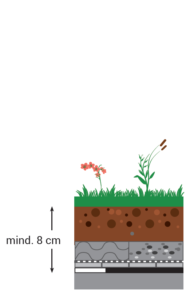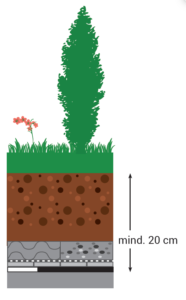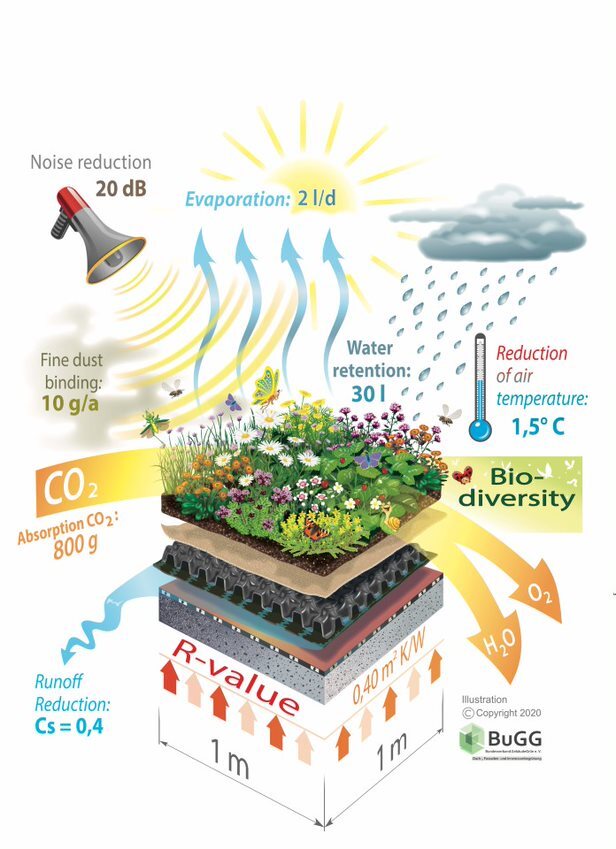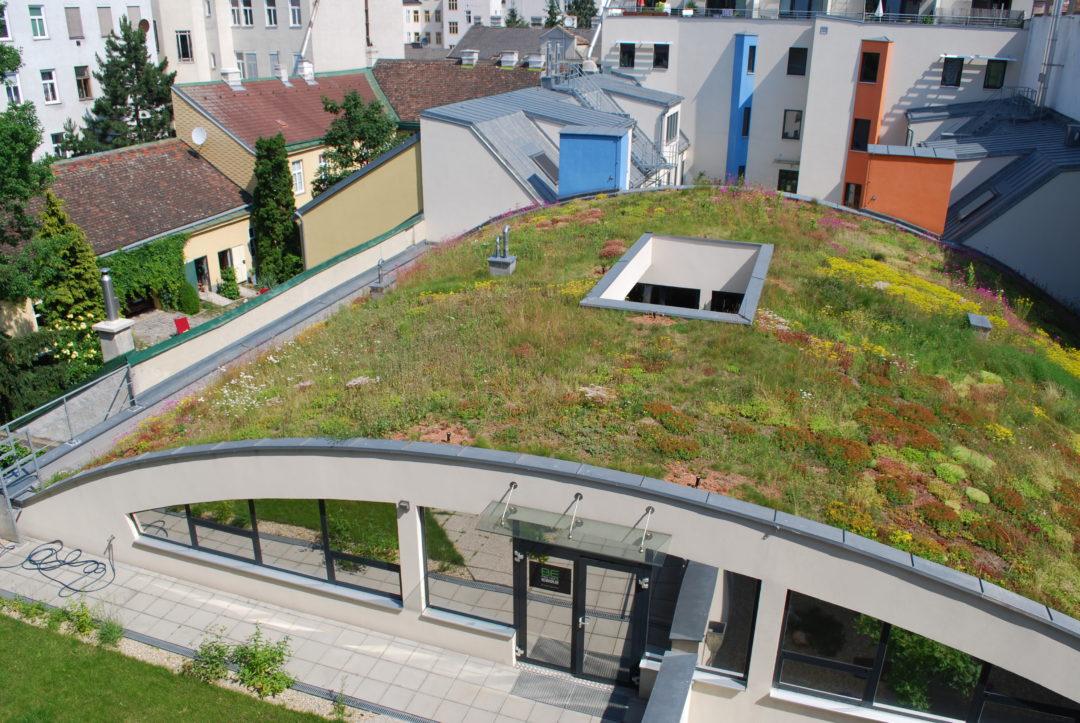Types of Green Roofs
Green roofs are internationally placed in two different ‘types’: Of course there is some cross over between the categories.
Extensive Green Roof

Extensive – natural low maintenance green roofs
- Adapted plant communities- sedum plants, bulbs, wild flowers and succulents lower contribution to urban climate and biodiversity
- Lower social co-benefits (often inaccessible)
- Minimal maintenance required (supply of water and nutrients mostly through natural processes)
- Shallow build-up height (30-150 mm)
- Weight 50-250 kg / m²
- Low capital cost
- Less technical expertise needed
- Easy to implement as a retrofitting method for existing structures
Intensive Green Roof

Intensive – parks and gardens including Urban Agriculture
- Ornamental lawn, summer flowers, demanding shrubs, bushes and trees
- Higher contribution to urban climate and biodiversity
- High social co-benefits i.e. recreation, agriculture
- Regular maintenance required
- Build-up height depending on plant selection vary between 300-1000 mm
- Weight >150 kg/m² up to 2000 kg/m²
- Higher capital cost
- More complex systems and greater expertise needed
- More suitable for particularly sturdy
The planning, implementation and maintenance of all these types is covered in the UK Green Roof Code of Practice. known as the GRO code. All green roof codes of practice globally are based on the German FLL.
Although extensive green roofs are perceived as using sedums and succulents, wildflowers can be used. This is an approach that is common in the UK and Switzerland. In the UK there are three sub-categories:
- Extensive sedum
- Extensive biodiverse
- Brown roofs
In the recent past, which Livingroofs.org was partly responsible for, brown roofs was a widely used term. Although some people still refer to old style brown roofs, they should be considered as extensive biodiverse roofs. They should also be designed and considered as ecological landscapes and not as a product.
A summary of the general characteristics of each category can be seen below. Although there is some cross over, the maintenance, costs and structural requirements do differ. Furthermore we have provided an overview of the broad benefits to the environment of each.
| Type ➔ | Extensive | Semi-intensive | Intensive |
|---|---|---|---|
| Use | Ecological Landscape | Garden/Ecological Landscape | Garden/Park |
| Type of vegetation | Moss-Herbs-Grasses | Grass-Herbs-Shrubs | Lawn/Perennials, Shrubs, Trees |
| Benefit | W,T,B | W,T,B,A | W,T,B,A |
| Depth of Substrate | 60-200mm | 120-250mm | 150-400mm |
| Weight | 60-150 kg/m² | 120-200 kg/m² | 180-500 kg/m² |
| Cost | Low | Periodic | High |
Solar green roofs
A solar green roof, also called biosolar roof, is a combination of photovoltaic panels and a green roof. The integrated mounting solution allows the substrate and vegetation to provide the ballasted installation mechanism. This eliminates the need to penetrate the waterproofing to secure the mounting units directly to the roof itself.
Solar green roofs have been implemented in various ways for decades. This combination has special advantages:
- increased efficiency of the solar system
- increase in biodiversity
- protection of the water proof layer from thermal and mechanical stress
- point loads can be avoided
Construction types
The solar panels can be arranged in various combinations, enabling a multifunctional use of the available surface. Depending on the space to be used and the desired function of the green surface, the arrangement of the technology can be one of the following:

If the solar panels are installed above the greenery, it needs to be assured that the distance is sufficiently measured. Furthermore, an appropriate water distribution must be guaranteed underneath the panels as well as a consistent water distribution throughout the green roof. The arrays of vertically mounted bifacial solar modules optimize the performance and allows the vegetation to grow freely. In case the solar panels are mounted more than 2 m above the green roof, it can also be referred to as pagodas (see example projects). This arrangement allows for a multifunctional use of the solar green roof, creating shaded spaces underneath the solar system.
Green Roof Benefits
click on the individual benefits to learn more …
Reduction of Urban Heat Island
Research in Tyndale Centre for climate change suggests we need a 10% increase in green space in our cities to combat climate change. This is particularly relevant to the reduction in the Urban Heat Island Effect [UHIE]. Green roofs are recognized to have a positive effect on reducing the UHIE
Biodiversity
Green roofs can provide important refuges for wildlife in urban areas. Research in Switzerland and the UK has demonstrated that green roofs can provide important refuges for rare invertebrate populations.
Water
Green roofs can significantly reduce the surface run off volumes and rates of rainfall leaving roofs. As a source control mechanism in the Sustainable Urban Drainage System green roofs can help reduce flash floods as a consequence of intense rainfall events. This will become increasingly important as a consequence of climate change.
Green roofs also improve the quality of water and although the amount of water is reduced it is possible to rainfall harvest from roofs that have been greened.
Thermal Performance
Green roofs cannot be given a U-value at present. However they have been shown to significantly reduce the need for air conditioning in summer and can provide a degree of insulation in winter.
Sound Insulation
The combination of soil, plants and trapped layers of air within green roof systems can act as a sound insulation barrier. Sound waves are absorbed, reflected or deflected. The growing medium tends to block lower sound frequencies whilst the plants block higher frequencies.
Protection of Waterproofing
The original green roofs in Germany stem from covering wet bitumen with 6cm of sand, which became vegetated. This covering was to protect the wet bitumen from fire. Green roofs have now been shown to double if not triple the life of waterproofing membranes beneath the green roof.
Air Quality
Airborne particles and pollutants are filtered from the atmosphere by the substrates and vegetation on a green roof.
Amenity Space
In dense urban environments there is often a lack of green space for residents. Roof Gardens and roof top parks provide important green spaces to improve the quality of life for urban residents.
Urban Agriculture
Urban Rooftop Food Growing – roofs strong enough to provide a space for urban food growing. Although many large flat roofs may not have the loading capabilities to hold food growing, some roofs will and the many balconies in urban areas are ideal.
A square metre of green roof


